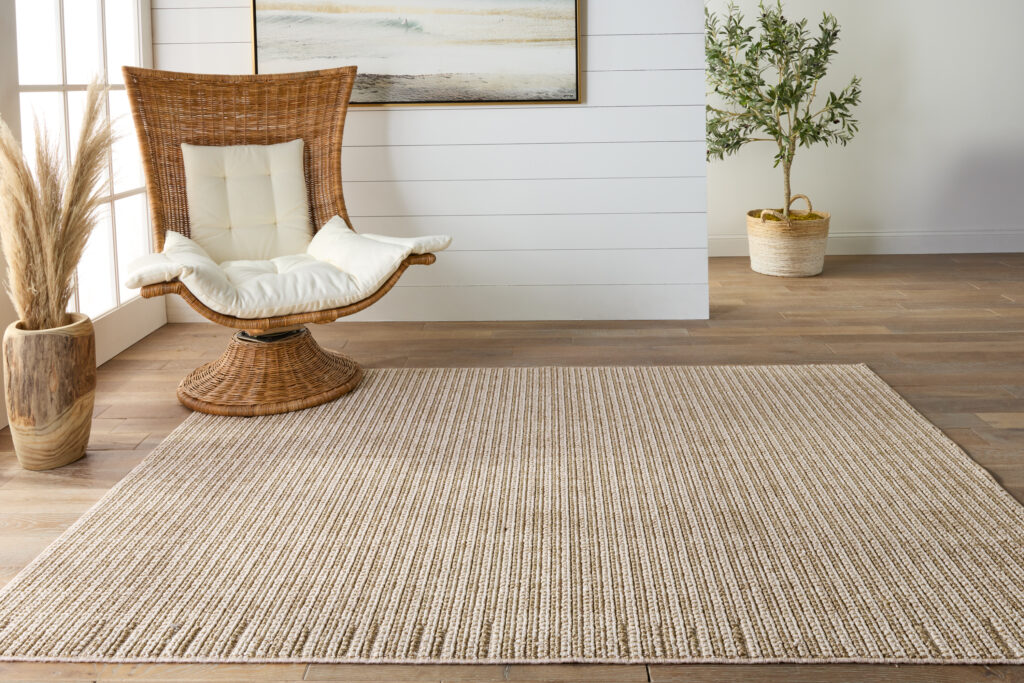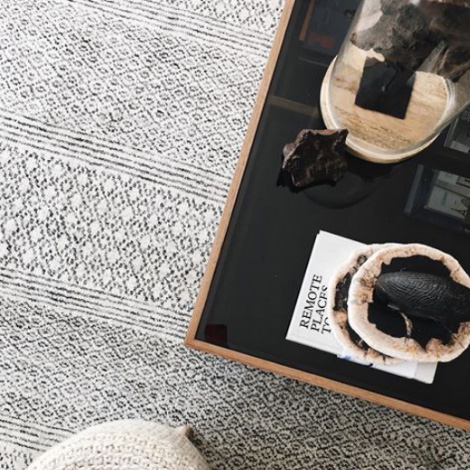With the lines between inside and out blurring, home decor needs are evolving. The outdoors have become an extension of our interiors, while living spaces now require more durability and performance. Here’s everything you need to know about design’s sought-after outdoor-friendly materials.

Jaipur Living‘s Rebecca collection is handcrafted from recycled PET.
Material World
Polyester and polypropylene are the most popular fibers for outdoor rugs. Thanks to their hydrophobic nature, they repel water and help prevent molding and rot. While both fibers are man-made, each has its own benefits. Polypropylene’s solution-dyed nature means its color absorbs all the way through the fiber, preventing fading and allowing for vibrant, bold hues. Polyester, however, has a more luxurious touch and is sought after for its soft feel underfoot.
Newer to the scene is recycled PET, a fiber made from plastic water bottles. Once plastic bottles are melted down, fibers are extruded and spun to mimic natural yarn, like wool. All Jaipur Living rugs fabricated with recycled PET are handmade and boast high-quality standards.
See also: Life Alfresco: The Indoor/Outdoor Guide

The handwoven Nirvana collection features a neutral colorway.
Construction Zone
While most outdoor rugs are power loomed, they can be crafted using any method, including hand-knotted, handwoven, braided, flat-woven, and hooked—a process similar to hand-tufting. Here’s an intro into each method:
Hand-Knot
Made from individually made knots tied one row at a time on a vertical loom, hand-knotted rugs take artisans around 240 days to craft by hand.
Handwoven
Also called hand-loomed rugs, these styles are made on hand-operated looms. Weavers use a rod to drive fibers vertically across the loom and back again.
Hand-Tufted & Hand-Hooked
In hand-tufted rugs, yarn is hand punched through a prewoven fabric with a specialized tufting device. For hand-hooked rugs, there is no shearing after the tufting process, resulting in an uncut, looped pile.
Flat-Woven
Flat-woven rugs, or hurries and kilims, have a much flatter finish thanks to their warp and weft threads, which run perpendicular to the other.
Power Loomed
Made on electrically powered looms, these rugs feature a wide range of colors, complex designs, and shorter lead times. They also tend to be easy care because they are often made with synthetic fibers like polyester, polypropylene, and recycled PET.
For more on rug constructions and materials, explore our Rugs101 Guide.

The best-selling Colours collection adds a burst of color to outdoor spaces.
Traffic Report
Outdoor rugs are ideal for high traffic areas and are typically kid and pet friendly. But be careful! Hooked or looped styles are more prone to damage from dog and cat claws.
While synthetic fibers tend to be more durable, which yarn is woven makes a difference. Polypropylene is the more durable of the outdoor fibers and ideal for high-traffic areas, where as polyester’s plush character means it can wear down more quickly and lose texture faster in high-traffic spaces. Recycled PET sits in the middle: It’s a durable fiber that’s easy to clean, soft underfoot, and amenable to high traffic.
See also: 5 Rules For Safe Rug Storage

The Paradizo collection’s durable, weather-resistant fibers help create a natural, flat-woven look.
In Situ
Expect outdoor rugs to last five to seven years—shorter in more humid climates. Help expand their lifespan with the use of an outdoor rug pad and avoid placing rugs directly on wood or cement, which can trap in moisture.
Insider’s tip: Outdoor rug pads are designed not to break down in the elements and allow the rug to breath, further protecting from mold and mildew.

The Settia collection of indoor/outdoor pillows provide a punch of color, a woven look, and twisted and knotted tassels.
Clean & Care
Whether placed inside or out, the cleaning and care guidelines for indoor/outdoor rugs are generally the same and vary by material and construction. Don’t forget: There are dedicated rug pads for indoor or outdoor use.
In general, blot stains immediately and use a mild soap mixed with equal parts white vinegar and water to clean. The beauty of indoor/outdoor rugs is that they can be hosed off outside and hung to dry. Ensure your rug is completely dry before placing it back in its proper home.
For more on cleaning and care, read our guide.







